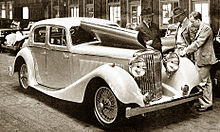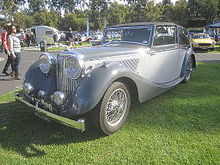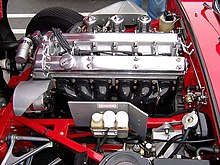| Jaguar Cars Ltd. | |
|---|---|
| Тип | Частная компания |
| Основание | 1922 |
| Упразднена | 31 декабря 2012 |
| Основатели | Уильям Лайонс и Уильям Уолмсли |
| Расположение |  Великобритания : Ковентри Великобритания : Ковентри |
| Ключевые фигуры | Сайрус Мистри (председатель совета директоров Tata Group) [1] Ральф Спет (CEO Jaguar Land Rover) [2] Адриан Холлмарк (глобальный бренд-менеджер Jaguar Cars) [3] |
| Отрасль | Автомобильная промышленность |
| Продукция | Легковые автомобили |
| Материнская компания | Tata Motors |
| Сайт | jaguar.ru |
| Медиафайлы на Викискладе | |
Jaguar Cars (Ягуар [4] ) — бренд транснациональной автомобилестроительной компании Jaguar Land Rover. Штаб-квартира находится в пригороде Ковентри графства Уэст-Мидлендс. С 2008 года принадлежит индийской Tata Motors. [5]
Компания Jaguar была основана в 1922 году сначала как Swallow Sidecar Company и производила мотоколяски. После Второй мировой войны название было изменено на «Jaguar», чтобы избежать неблагоприятного сочетания «SS». В 1966 году объединилась с компанией British Motor Corporation, которая стала называться British Motor Holdings (BMH), в 1968 объединилась с Layland Motor Corporation и переименована в British Leyland. В 1975 году компания была национализирована.
«Ягуар» был отделён от British Leyland и вышел на Лондонскую фондовую биржу в 1984 году и до 1990 года его акции были составляющей индекса FTSE 100, пока автопроизводитель не был приобретён компанией Ford. В последнее время Jaguar производит автомобили для Премьер-министра Великобритании [6] , последней была предоставлена модель XJ в мае 2010, а также для королевы Елизаветы II и принца Чарльза. С 1987 года [7] «Ягуары» разрабатываются в инженерном центре Jaguar Land Rover на заводе Утли в Ковентри и в Гэйдон центре в Уорикшире. Производятся на сборочном заводе Castle Bromwich в Бирмингеме, ожидается, что часть производства начнётся в Солихалле.
В сентябре 2013 анонсированы планы об открытии R&D центра в Уорикском университете в Ковентри, стоимостью 100 миллионов фунтов для создания нового поколения автомобильных технологий. Автопроизводитель заявил, что около 1000 учёных и инженеров будут работать над этим, и что конструирование начнётся в 2014 году. [8]
Содержание
История [ править | править код ]




Существование компании началось с 20-х годов XX века. В это время она была компанией Swallow Sidecar, и производила коляски для мотоциклов. Это не приносило особого дохода, после чего фирма сменила специализацию на производство комплектующих для Austin 7. После выполненного в 1927 году большого заказа доход позволил компании расширить своё производство и производить комплектующие моделей Fiat 509A, Morris Cowley, Wolseley Hornet, а затем стала сама проектировать и разрабатывать новые модели автомобилей.
В середине XX века компания сменила название на Jaguar, так как инициалы компании SS ассоциировались после войны с нацистскими режимами. В это же время появился Jaguar Mk VII, в котором была увеличена мощность двигателя до 190 лошадиных сил. В 1950 году Jaguar начал сотрудничество с фирмой Daimler Motor Company (не путать с Daimler-Benz), которая выпускала автомобили, по классу близкие к Ягуарам. С 1960 года Daimler стала частью компании Jaguar. Сама компания, у которой начались трудности с продажами, в 1966 году начала сотрудничать и вошла в состав Бритиш Мотор. Начиная с этого времени модели Jaguar стали пользоваться все большей популярностью.
К 1960-м годам концерн Jaguar завоевывает американский рынок моделями Jaguar XK150 и XK150 Roadster с объёмом двигателя до 3,4 литра. С 1960-х по 1980-е года были выпущены серии спортивных моделей, а также седанов, которые продавались по высокой цене, но отличались повышенным качеством.
В конце 1960-х была выпущена модель Jaguar с модернизированным 6-цилиндровым двигателем. Через некоторое время, в начале 1970-х, начался выпуск Jaguar XJ12, с 12-цилиндровым двигателем, мощностью 311 лошадиных сил. С 1968 по 1983 годы были выпущены следующие модели: Jaguar XJ8 — седан, XJR 4.0 Supercharged, Jaguar XJ-C — купе, Jaguar XJ-S — на нём был впервые установлен двигатель AJ6. В 1988 году была выпущена новая модель, которая снова получила широкую известность — Jaguar XJ220, однако позднее он был изменен и показан в Токио на автомобильной выставке.
В конце 1980-х был открыт филиал компании Jaguar Sport, производивший спортивные модели автомобилей. Тогда же Jaguar становится отделением фирмы Ford. В конце 1990-х в Швейцарии на выставке была показана модель спортивного автомобиля в кузове «купе», а также кабриолет.
В 2000—2004 гг. автомобили марки Jaguar снова принимали участие в гонках Формула-1 в качестве команды «Ягуар», используя двигатели Cosworth. Специально для этого были выпущены автомобили модели F-Type Concept и Silverstone.
В 2019 годe электрокару Jaguar I-Pace присудили награду «Автомобиль 2018 года в Европе». Также можно заметить, что этот приз компания получает впервые [9] .
В 2019 году компания анонсировала флагманский кроссовер J-Pace, основанный на новой, полностью алюминиевой платформе MLA, которую также планируется использовать в новом поколении внедорожника Range Rover. Автомобиль лишится механического полного привода — в движение заднюю ось будет приводить электромотор, переднюю – традиционный двигатель внутреннего сгорания [10] . Выход автомобиля запланирован на 2021 год.
Собственники и руководство [ править | править код ]
Jaguar Cars полностью контролируется структурами индийской автомобилестроительной компании Tata Motors, входя в состав группы Jaguar Land Rover [11] .
Деятельность [ править | править код ]
Группе Jaguar Land Rover принадлежат три завода в Великобритании и один в Индии [12] [13] . В ближайшем будущем готовится открытие новых производств в Китае [14] и Саудовской Аравии [15] .
Продажи в России [ править | править код ]
Продажи новых автомобилей через сеть официальных дилерских центров в России:
| Год | S-Type | XF | XJ | XK | X-Type | Всего | Динамика |
|---|---|---|---|---|---|---|---|
| 2006 [16] [17] | 150 | — | 105 | 54 | 584 | 893 | ▲ 71 % |
| 2007 [18] [19] | 180 | — | 120 | 112 | 723 | 1135 | ▲ 27 % |
| 2008 [20] [21] | 32 | 826 | 124 | 123 | 584 | 1689 | ▲ 49 % |
| 2009 [22] [23] | — | 578 | 63 | 51 | 241 | 933 | ▼ 45 % |
| 2010 [24] [25] | — | 573 | 225 | 45 | 15 | 858 | ▼ 8 % |
| 2011 [26] [27] | — | 765 | 381 | 35 | 1 | 1182 | ▲ 38 % |
| 2012 [28] [29] | — | 1059 | 406 | 41 | — | 1506 | ▲ 27 % |
Модельный ряд [ править | править код ]
Представительские седаны [ править | править код ]
- Jaguar 2½ Litre saloon (1935—1948)
- Jaguar 3½ Litre saloon (1937—1948)
- Jaguar Mark V (1948—1951)
- Jaguar Mark VII (& VIIM) (1951—1957)
- Jaguar Mark VIII (1957—1958)
- Jaguar Mark IX (1959—1961)
- Jaguar Mark X (1961—1966)
- Jaguar 420G (1966—1970)
- Jaguar XJ6 Series 1, 2 & 3 (1968—1987)
- Jaguar XJ12 (1972—1992)
- Jaguar XJ6 (XJ40) (1986—1994)
- Jaguar XJ12 (XJ81) (1993—1994)
- Jaguar XJ6 & XJ12 (X300 & X301) (1995—1997)
- Jaguar XJ8 (X308) (1998—2003)
- Jaguar XJ (X350) (2004—2009)
- Jaguar XJ (X351) (c 2009 года)
Компактные седаны [ править | править код ]
- Jaguar 1½ Litre saloon (1935—1949)
- Jaguar Mark 1 (1955—1959)
- Jaguar Mark 2 (1959—1967)
- Jaguar S-type (1963—1968)
- Jaguar 420 (1966—1968)
- Jaguar 240 & 340 (1966—1968)
- Jaguar S-Type (1999—2008)
- Jaguar X-Type (2001—2009)
- Jaguar XF (с 2008 года)
- Jaguar XE (с 2015 года)
Спортивные [ править | править код ]
- Jaguar XK120 (1948—1954)
- Jaguar XK140 (1954—1957)
- Jaguar XK150 (1957—1961)
- Jaguar E-Type (1961—1974)
- Jaguar XJ-S (1975—1996)
- Jaguar XJ220 (1992—1994)
- Jaguar XK8, Jaguar XKR (X100) (1996—2006)
- Jaguar XK, Jaguar XKR (X150) (2006—2014)
- Jaguar F-Type (с 2013 года)
Гоночные [ править | править код ]
- Jaguar XK-120C (1951—1952), победитель 24 часа Ле-Мана[30]
- Jaguar C-Type (1951—1953), победитель 24 часа Ле-Мана[31]
- Jaguar D-Type (1954—1957), трёхкратный победитель 24 часа Ле-Мана[32][33][34]
- Jaguar E-Type Lightweight (1963—1964)
- Jaguar XJR-5 до XJR-17 (1985—1992), двукратный победитель 24 часа Ле-Мана[35][36] , трёхкратный победитель World Sportscar Championship
- Jaguar XFR (2009)
- Jaguar XKR GT2 RSR (2010)
- Jaguar R1 (2000), гоночный автомобиль Формулы-1
- Jaguar R2 (2001), гоночный автомобиль Формулы-1
- Jaguar R3 (2001), гоночный автомобиль Формулы-1
- Jaguar R4 (2003), гоночный автомобиль Формулы-1
- Jaguar R5 (2004), гоночный автомобиль Формулы-1
Кроссоверы [ править | править код ]
- Jaguar F-Pace (с 2016 года)
- Jaguar E-Pace (с 2018 года)
- Jaguar i-Pace (с 2018 года) Обладатель титула "Автомобиль года 2019" (COTY-2019)
Концепт-кары [ править | править код ]
- E1A — Первый прототип E-Type
- E2A — Второй прототип E-Type
- XJ13 (1966)
- Pirana (1967)
- XK180 (1998)
- F-Type (2000) — Родстер
- R-Coupé (2002) — 4-местное купе класса «люкс», конкурент Bentley Continental GT
- Fuore XF 10 (2003)
- R-D6 (2003) — Компактное 4-местное купе
- XK-RR — Высокомощная версия последнего поколения купеJaguar XK
- XK-RS — Высокомощная версия последнего поколения кабриолета Jaguar XK
- Concept Eight (2004) — Суперлюкс версия длиннобазного Jaguar XJ
- C-X17 (2013) — кроссовер
- C-XF (2007)
- C-X75 Concept (2010) — Суперкар
- XKR 75 (2010) — Суперкар
- B99 (Bertone 99) (2011)
Фотографии [ править | править код ]
Jaguar Mark X (1963)


Jaguar S-Type (Северная Америка) (2006—2008)
1920-е
История Jaguar — это история великого бренда, которая началась в 1922 году с основания предприятия по производству мотоколясок Swallow Sidecar двумя компаньонами — Уильямом Лайонсом (William Lyons) и Уильямом Уолмсли (William Walmsley). К 1926 году компания Swallow превратилась в ведущего производителя мотоциклетных колясок в Британии, ежемесячно продававшего по несколько сотен экземпляров.
Несмотря на обвал Уолл-стрит в 1929 году свежие яркие модели Swallow пользовались огромным успехом.

1930-e
Важным этапом в развитии бизнеса стало партнерство Swallow с компанией Standard Motor, которая стала поставлять двигатели и шасси. Расширение модельного ряда требовало нового имиджа и новых названий. Вот почему компания стала именоваться S.S. Cars, а выпускаемые автомобили — S.S.I и S.S.II. В 1934 году Уильям Уолмсли отошел от дел, переключившись на производство трейлеров. Уильям Лайонс выкупил его долю и стал единоличным собственником компании.

1940-e
В 1945 году компания стала называться Jaguar Cars. В 1949 году на Британском автосалоне был впервые представлен XK120. Название XK120 означало модель двигателя и максимальную скорость (в милях в час). Впрочем, во время заездов на бельгийской трассе Остенде — Яббеке автомобиль смог развить скорость 132 миль/ч (212 км/ч), обретя славу «самого быстрого серийного автомобиля в мире».

1950-e
В 1951 приходится триумф экипажа Jaguar в составе Питера Уокера (Peter Walker) и Питера Уайтхеда (Peter Whitehead) в Ле-Мане. Это достижение еще более способствовало славе Jaguar. В 1954 году преемником C‑Type стал автомобиль D‑Type — детище дизайнера Малколма Сэйера (Malcolm Sayer). Конструкция D‑Type была настолько аэродинамически эффективной, что его максимальная скорость увеличилась до 170 миль/ч (270 км/ч), и в испытательных заездах перед гонкой Ле-Ман в 1954 году он побил прошлогодний рекорд прохождения круга на 5 секунд.

1960-е
Великим достижением этих лет стало появление нового спорткара E‑Type в 1961 году.
11 июля 1966 года в лондонской гостинице Great Eastern сэр Уильям Лайонс и сэр Джордж Гарриман выступили с совместным заявлением о слиянии British Motor Corporation Ltd. и Jaguar Cars Ltd. и образовании компании British Motor Holdings.
1968 год стал годом рождения легендарной серии XJ. Седан XJ6, спроектированный сэром Лайонсом, стал его самым долгоживущим детищем: за последующие 24 года было продано более 400 тысяч штук.

1970-е
В 1972 году произошли серьезные кадровые изменения. Уильям Лайонс ушел в отставку. Пост председателя совета директоров и генерального директора Jaguar Cars занял Фрэнк «Лофти» Ингленд (Frank England).
В 1975 году на смену E‑Type пришел XJ-S. Модель XJ-S, созданная Малколмом Сэйером как замена культовому E‑Type, унаследовала спортивный дух Jaguar в неповторимо роскошном и элегантном воплощении.

1980-е
В 1980 году у руля компании становится известный предприниматель Джон Игэн (John Egan), кандидатуру которого поддержал сэр Уильям Лайонс и которому удалось сохранить великие традиции Jaguar. В 1984 году правительство Маргарет Тэтчер приватизировало компанию Jaguar Cars, сохранив за собой «золотую акцию», что защищало Jaguar Cars от поглощения до 1990 года.
В 1985 году скончался великий основатель Jaguar Уильям Лайонс.

1990-е
Первого января 1990 года Ford официально стал владельцем Jaguar Cars. Одним из главных результатов прихода Ford стало внедрение на предприятиях Jaguar постоянно совершенствующейся системы управления и координации между различными подразделениями компании.
В 1996 году на свет появилась модель XK8, воплотившая лучшие черты марки. XK8 превзошел все ожидания и стал самым быстро продаваемым спортивным автомобилем в истории Jaguar.

2000-е
В 2008 году компания Tata Motors завершила сделку по приобретению Jaguar и Land Rover у компании Ford Motor. Еще одной яркой новинкой стал суперседан XF, покоривший поклонников марки классическим для Jaguar сочетанием мощности, комфорта и легкости в управлении. Эта модель, как и все новые автомобили марки, создана под руководством главного дизайнера Яна Каллума.
В 2012 году состоялась премьера «самого спортивного автомобиля Jaguar за последние 50 лет» —- F‑TYPE. С пятилитровым двигателем V8 мощностью 495 л.с. кабриолет способен разгоняться до максимальных 300 км/ч. Для ускорения до сотни ему требуется всего 4,3 секунды, а от 80 до 120 км/ч — 2,5 секунды.
| Product type | Cars |
|---|---|
| Owner | Jaguar Land Rover (since 2013) [1] |
| Produced by | Jaguar Land Rover |
| Country | United Kingdom |
| Introduced | 1935 |
| Related brands | Land Rover |
| Markets | Worldwide |
| Previous owners | Jaguar Cars (1935–2012) |
| Tagline | "The Art of Performance" |
| Website | jaguar .com |
- (1933–1945) S. S. Cars Limited, a public listed company LSE
- (1945–1966) renamed Jaguar Cars Limited LSE
- British Motor Holdings (1966–1968)
- British Leyland (1968–1984)
- Ford Motor Company (1990–2008)
- Tata Motors (2008–2012)
Jaguar ( UK: / ˈ dʒ æ ɡ j u ər / , US: / ˈ dʒ æ ɡ w ɑːr / ) is the luxury vehicle brand of Jaguar Land Rover, [1] [2] a British multinational car manufacturer with its headquarters in Whitley, Coventry, England. Jaguar Cars was the company that was responsible for the production of Jaguar cars until its operations were fully merged with those of Land Rover to form Jaguar Land Rover on 1 January 2013.
Jaguar’s business was founded as the Swallow S >[3] the resulting enlarged company now being renamed as British Motor Holdings (BMH), which in 1968 merged with Leyland Motor Corporation and became British Leyland, itself to be nationalised in 1975.
Jaguar was spun off from British Leyland and was listed on the London Stock Exchange in 1984, becoming a constituent of the FTSE 100 Index until it was acquired by Ford in 1990. [4] Jaguar has, in recent years, manufactured cars for the British Prime Minister, the most recent delivery being an XJ in May 2010. [5] The company also holds royal warrants from Queen Elizabeth II and Prince Charles. [6]
In 1990 Ford acquired Jaguar Cars and it remained in their ownership, joined in 2000 by Land Rover, till 2008. Ford then sold both Jaguar and Land Rover to Tata Motors. Tata created Jaguar Land Rover as a subsidiary holding company. At operating company level, in 2013 Jaguar Cars was merged with Land Rover to form Jaguar Land Rover Limited as the single design, manufacture, sales company and brand owner for both Jaguar and Land Rover vehicles.
Since the Ford ownership era, Jaguar and Land Rover have used joint design facilities in engineering centres at Whitley in Coventry and Gaydon in Warwickshire and Jaguar cars have been assembled in plants at Castle Bromwich and Solihull.
Contents
History
Founding
The Swallow Sidecar Company was founded in 1922 by two motorcycle enthusiasts, William Lyons and William Walmsley. In 1934 Walmsley elected to sell-out and in order to buy the Swallow business (but not the company which was liquidated) Lyons formed S.S. Cars Limited, finding new capital by issuing shares to the public.


Jaguar first appeared in September 1935 as a model name on an SS 2½-litre sports saloon. [7] [8] A matching open two seater sports model with a 3½-litre engine was named SS Jaguar 100.
On 23 March 1945 the S. S. Cars shareholders in general meeting agreed to change the company’s name to Jaguar Cars Limited. Sa >[9]
Though five years of pent-up demand ensured plenty of buyers production was hampered by shortage of materials, particularly steel, issued to manufacturers until the 1950s by a central planning authority under strict government control. Jaguar sold Motor Panels, a pressed steel body manufacturing company bought in the late 1930s, to steel and components manufacturer Rubery Owen, [10] and Jaguar bought from John Black’s Standard Motor Company the plant where Standard built Jaguar’s six-cylinder engines. [10] From this time Jaguar was entirely dependent for their bodies on external suppliers, in particular then independent Pressed Steel and in 1966 that carried them into BMC, BMH and British Leyland.

Jaguar made its name by producing a series of successful eye-catching sports cars, the Jaguar XK120 (1948–54), Jaguar XK140 (1954–57), Jaguar XK150 (1957–61), and Jaguar E-Type (1961–75), all embodying Lyons’ mantra of "value for money". [11] The sports cars were successful in international motorsport, a path followed in the 1950s to prove the engineering integrity of the company’s products.
Jaguar’s sales slogan for years was "Grace, Space, Pace", [12] a mantra epitomised by the record sales achieved by the MK VII, IX, Mks I and II saloons and later the XJ6. [ citation needed ] During the time this slogan was used, but the exact text varied. [13] [14] [15] [16]
The core of Bill Lyons’ success following WWII was the twin-cam straight six engine, conceived pre-war and realised while engineers at the Coventry plant were dividing their time between fire-watching and designing the new power plant. It had a hemispherical cross-flow cylinder head with valves inclined from the vertical; originally at 30 degrees (inlet) and 45 degrees (exhaust) and later standardised to 45 degrees for both inlet and exhaust.

As fuel octane ratings were relatively low from 1948 onwards, three piston configuration were offered: domed (high octane), flat (medium octane), and dished (low octane).
The main designer, William "Bill" Heynes, assisted by Walter "Wally" Hassan, was determined to develop the Twin OHC unit. Bill Lyons agreed over misgivings from Hassan. It was risky to take what had previously been considered a racing or low-volume and cantankerous engine needing constant fettling and apply it to reasonable volume production saloon cars.
The subsequent engine (in various versions) was the mainstay powerplant of Jaguar, used in the XK 120, Mk VII Saloon, Mk I and II Saloons and XK 140 and 150. It was also employed in the E Type, itself a development from the race winning and Le Mans conquering C and D Type Sports Racing cars refined as the short-lived XKSS, a road-legal D-Type.
Few engine types have demonstrated such ubiquity and longevity: Jaguar used the Twin OHC XK Engine, as it came to be known, in the Jaguar XJ6 saloon from 1969 through 1992, and employed in a J60 variant as the power plant in such diverse vehicles as the British Army’s Combat Vehicle Reconnaissance (Tracked) family of vehicles, as well as the Fox armoured reconnaissance vehicle, the Ferret Scout Car, and the Stonefield four-wheel-drive all-terrain lorry. Properly maintained, the standard production XK Engine would achieve 200,000 miles of useful life.
Two of the proudest moments in Jaguar’s long history in motor sport involved winning the Le Mans 24 hours race, firstly in 1951 and again in 1953. Victory at the 1955 Le Mans was overshadowed by it being the occasion of the worst motorsport accident in history. Later in the hands of the Scottish racing team Ecurie Ecosse two more wins were added in 1956 and 1957.
In spite of such a performance orientation, it was always Lyons’ intention to build the business by producing world-class sporting saloons in larger numbers than the sports car market could support. Jaguar secured financial stability and a reputation for excellence with a series of elegantly styled luxury saloons that included the 3-litre and 3½ litre cars, the Mark VII, VIII, and IX, the compact Mark I and 2, and the XJ6 and XJ12. All were deemed very good values, with comfortable rides, good handling, high performance, and great style.
Combined with the trend-setting XK 120, XK 140, and XK 150 series of sports car, and nonpareil E-Type, [ citation needed ] Jaguar’s elan as a prestige motorcar manufacturer had few rivals. The company’s post-War achievements are remarkable, considering both the shortages that drove Britain (the Ministry of Supply still allocated raw materials) and the state of metallurgical development of the era.
Daimler
In 1950, Jaguar agreed to lease from the Ministry of Supply the Daimler Shadow 2 factory in Browns Lane, Allesley, Coventry, which at the time was being used by The Daimler Company Limited and moved to the new site from Foleshill over the next 12 months. [17] Jaguar purchased Daimler – not to be confused with Daimler-Benz or Daimler AG—in 1960 from BSA. From the late 1960s, Jaguar used the Daimler marque as a brand name for their most luxurious saloons. [18]
Ownership
An end to independence
Pressed Steel Company Limited made all Jaguar’s (monocoque) bodies leaving provision and installation of the mechanicals to Jaguar. In m >[19] Lyons became concerned about the future of Jaguar, partly because of the threat to ongoing supplies of bodies, and partly because of his age and lack of an heir. He therefore accepted BMC’s offer to merge with Jaguar to form British Motor (Holdings) Limited. [20] At a press conference on 11 July 1965 at the Great Eastern Hotel in London, Lyons and BMC chairman George Harriman announced, "Jaguar Group of companies is to merge with The British Motor Corporation Ltd., as the first step towards the setting up of a joint holding company to be called British Motor (Holdings) Limited". In due course BMC changed its name to British Motor Holdings [21] at the end of 1966.
BMH was pushed by the Government to merge with Leyland Motor Corporation Limited, manufacturer of Leyland bus and truck, Standard-Triumph and, since 1967, Rover vehicles. The result was British Leyland Motor Corporation, a new holding company which appeared in 1968, but the combination was not a success. A combination of poor decision making by the board along with the financial difficulties of, especially, the Austin-Morris division (previously BMC) led to the Ryder Report and to effective nationalisation in 1975. [ citation needed ]
Temporary return to independence
Over the next few years it became clear that because of the low regard for many of the group’s products insufficient capital could be prov >[22]

In July 1984, Jaguar was floated off as a separate company on the stock market – one of the Thatcher government’s many privatisations [23] – to create its own track record. [24]
Installed as chairman in 1980, Sir John Egan is credited for Jaguar’s unprecedented prosperity immediately after privatisation. In early 1986 Egan reported he had tackled the main problems that were holding Jaguar back from selling more cars: quality control, lagging delivery schedules, poor productivity. He la >[25] Commentators later pointed out he exploited an elderly model range (on which all development costs had been written off) and raised prices. He also intensified the effort to improve Jaguar’s quality. In the US the price increases were masked by a favourable exchange rate. [26]
Ford Motor Company era
Ford made offers to Jaguar’s US and UK shareholders to buy their shares in November 1989; Jaguar’s listing on the London Stock Exchange was removed on 28 February 1990. [27] In 1999 it became part of Ford’s new Premier Automotive Group along with Aston Martin, Volvo Cars and, from 2000, Land Rover. Under Ford’s ownership, Jaguar never made a profit. [28]
Under Ford’s ownership Jaguar expanded its range of products with the launch of the S-Type in 1999 and X-type in 2001. After PAG acquired Land Rover in May 2000 purchase by Ford, the brand became closely associated with Jaguar. In many countries they shared a common sales and distribution network (including shared dealerships), and some models shared components, although the only shared production facility was Halewood Body & Assembly – which manufactured the technically related X-Type and the Freelander 2. Operationally the two companies were effectively integrated under a common management structure within Ford’s PAG.
On 11 June 2007, Ford announced that it planned to sell Jaguar, along with Land Rover and retained the services of Goldman Sachs, Morgan Stanley and HSBC to advise it on the deal. The sale was initially expected to be announced by September 2007, but was delayed until March 2008. Private equity firms such as Alchemy Partners of the UK, TPG Capital, Ripplewood Holdings (which hired former Ford Europe executive Sir Nick Scheele to head its b >[29] [30]
Before the sale was announced, Anthony Bamford, chairman of British excavator manufacturer JCB had expressed interest in purchasing the company in August 2006, [31] but backed out upon learning that the sale would also involve Land Rover, which he d >[32]
Tata Motors era
On 1 January 2008, Ford formally declared that Tata was the preferred b >[33] Tata Motors also received endorsements from the Transport And General Worker’s Union (TGWU)-Amicus [34] combine as well as from Ford. [35] According to the rules of the auction process, this announcement would not automatically disqualify any other potential suitor. However, Ford (as well as representatives of Unite) would now be able to enter into detailed discussions with Tata concerning issues ranging from labour concerns (job security and pensions), technology (IT systems and engine production) and intellectual property, [36] as well as the final sale price. [37] Ford would also open its books for a more comprehensive due diligence by Tata. [38] On 18 March 2008, Reuters reported that American bankers Citigroup and JP Morgan would finance the deal with a US$3 billion loan. [39]
On 26 March 2008, Ford announced that it had agreed to sell its Jaguar and Land Rover operations to Tata Motors of India, and that they expected to complete the sale by the end of the second quarter of 2008. [40] Included in the deal were the rights to three other British brands, Jaguar’s own Daimler, as well as two dormant brands Lanchester and Rover. [41] On 2 June 2008, the sale to Tata was completed at a cost of £1.7 billion. [42] [43] [44]
On 18 January 2008, Tata Motors, a part of the Tata Group, established Jaguar Land Rover Limited as a British-registered and wholly owned subs >[45] On 1 January 2013, the group, which had been operating as two separate companies (Jaguar Cars Limited and Land Rover), although on an integrated basis, underwent a fundamental restructuring. The parent company was renamed to Jaguar Land Rover Automotive PLC, Jaguar Cars Limited was renamed to Jaguar Land Rover Limited and the assets (excluding certain Chinese interests) of Land Rover were transferred to it. The consequence was that Jaguar Land Rover Limited became responsible in the UK for the design, manufacture and marketing of both Jaguar and Land Rover products. [46]
Plants
From 1922 the Swallow S >[47] The company started using the Jaguar name whilst based in Holbrooks Lane.
In 1951, having outgrown the original Coventry site they moved to Browns Lane, which had been a wartime "shadow factory" run by The Daimler Company. The Browns Lane plant ceased trim and final operations in 2005, the X350 XJ having already moved to Castle Bromwich two years prior, with the XK and S-Type following. The Browns Lane plant, which continued producing veneer trim for a while and housed the Jaguar Daimler Heritage centre until it moved to the British Motor Museum site, has now been demolished and is being redeveloped.
Jaguar acquired the Whitley engineering centre from Peugeot in 1986; which had originally been part of Chrysler Europe which the French firm had owned since the late 1970s. The decision to offload the site to Jaguar came as Peugeot discontinued the Talbot brand for passenger cars. In 2016, Jaguar also moved into part of the old Peugeot/Chrysler/Rootes site in Ryton-on-Dunsmore which closed a decade earlier – this now is the home of Jaguar Land Rover’s classic restoration operation.
Jaguar’s Radford plant, originally a Daimler bus plant but later a Jaguar engine and axle plant, was closed by Ford in 1997 when it moved all Jaguar engine production to its Bridgend facility.
In 2000, Ford turned its Halewood plant over to Jaguar following the discontinuation of its long running Escort that year for Jaguar’s new X-Type model. It was later joined by the second-generation Land Rover Freelander 2, from 2007. Jaguars ceased being produced at Halewood in 2009 following the discontinuation of the X-Type; Halewood now becoming a Land Rover-only plant.
Since Jaguar Land Rover was formed following the merger of Jaguar Cars with Land Rover, facilities have been shared across several JLR sites, most of which are used for work on both the Jaguar and Land Rover brands.




